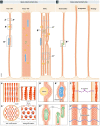Peering into tunneling nanotubes-The path forward
- PMID: 33646572
- PMCID: PMC8047439
- DOI: 10.15252/embj.2020105789
Peering into tunneling nanotubes-The path forward
Abstract
The identification of Tunneling Nanotubes (TNTs) and TNT-like structures signified a critical turning point in the field of cell-cell communication. With hypothesized roles in development and disease progression, TNTs' ability to transport biological cargo between distant cells has elevated these structures to a unique and privileged position among other mechanisms of intercellular communication. However, the field faces numerous challenges-some of the most pressing issues being the demonstration of TNTs in vivo and understanding how they form and function. Another stumbling block is represented by the vast disparity in structures classified as TNTs. In order to address this ambiguity, we propose a clear nomenclature and provide a comprehensive overview of the existing knowledge concerning TNTs. We also discuss their structure, formation-related pathways, biological function, as well as their proposed role in disease. Furthermore, we pinpoint gaps and dichotomies found across the field and highlight unexplored research avenues. Lastly, we review the methods employed to date and suggest the application of new technologies to better understand these elusive biological structures.
Keywords: actin protrusions; cell communication; cell signaling; tunneling nanotubes.
© 2021 The Authors.
Conflict of interest statement
The authors declare that they have no conflict of interest.
Figures



Similar articles
-
The Ways of Actin: Why Tunneling Nanotubes Are Unique Cell Protrusions.Trends Cell Biol. 2021 Feb;31(2):130-142. doi: 10.1016/j.tcb.2020.11.008. Epub 2020 Dec 9. Trends Cell Biol. 2021. PMID: 33309107 Review.
-
Cell communication by tunneling nanotubes: Implications in disease and therapeutic applications.J Cell Physiol. 2019 Feb;234(2):1130-1146. doi: 10.1002/jcp.27072. Epub 2018 Sep 12. J Cell Physiol. 2019. PMID: 30206931 Review.
-
Tunneling Nanotube-Mediated Communication: A Mechanism of Intercellular Nucleic Acid Transfer.Int J Mol Sci. 2022 May 14;23(10):5487. doi: 10.3390/ijms23105487. Int J Mol Sci. 2022. PMID: 35628298 Free PMC article. Review.
-
Structural and functional analysis of tunneling nanotubes (TnTs) using gCW STED and gconfocal approaches.Biol Cell. 2015 Nov;107(11):419-25. doi: 10.1111/boc.201500004. Epub 2015 Jul 17. Biol Cell. 2015. PMID: 26094971
-
Wiring through tunneling nanotubes--from electrical signals to organelle transfer.J Cell Sci. 2012 Mar 1;125(Pt 5):1089-98. doi: 10.1242/jcs.083279. Epub 2012 Mar 7. J Cell Sci. 2012. PMID: 22399801 Review.
Cited by
-
Enhancing drug penetration in solid tumors via nanomedicine: Evaluation models, strategies and perspectives.Bioact Mater. 2023 Oct 26;32:445-472. doi: 10.1016/j.bioactmat.2023.10.017. eCollection 2024 Feb. Bioact Mater. 2023. PMID: 37965242 Free PMC article. Review.
-
Mechanical properties of intercellular tunneling nanotubes formed by different mechanisms.Heliyon. 2024 Aug 15;10(17):e36265. doi: 10.1016/j.heliyon.2024.e36265. eCollection 2024 Sep 15. Heliyon. 2024. PMID: 39263182 Free PMC article. Review.
-
Zika virus NS1 drives tunneling nanotube formation for mitochondrial transfer and stealth transmission in trophoblasts.Nat Commun. 2025 Feb 20;16(1):1803. doi: 10.1038/s41467-025-56927-2. Nat Commun. 2025. PMID: 39979240 Free PMC article.
-
Zika Virus NS1 Drives Tunneling Nanotube Formation for Mitochondrial Transfer, Enhanced Survival, Interferon Evasion, and Stealth Transmission in Trophoblasts.Res Sq [Preprint]. 2023 Dec 6:rs.3.rs-3674059. doi: 10.21203/rs.3.rs-3674059/v1. Res Sq. 2023. Update in: Nat Commun. 2025 Feb 20;16(1):1803. doi: 10.1038/s41467-025-56927-2. PMID: 38106210 Free PMC article. Updated. Preprint.
-
Programmed disassembly of a microtubule-based membrane protrusion network coordinates 3D epithelial morphogenesis in Drosophila.EMBO J. 2024 Feb;43(4):568-594. doi: 10.1038/s44318-023-00025-w. Epub 2024 Jan 23. EMBO J. 2024. PMID: 38263333 Free PMC article.
References
-
- Abounit S, Delage E, Zurzolo C (2015) Identification and characterization of tunneling nanotubes for intercellular trafficking. Curr Protoc Cell Biol 67: 12.10.1‐21 - PubMed
-
- Abounit S, Zurzolo C (2012) Wiring through tunneling nanotubes–from electrical signals to organelle transfer. J Cell Sci 125: 1089–1098 - PubMed
Publication types
MeSH terms
LinkOut - more resources
Full Text Sources
Other Literature Sources

